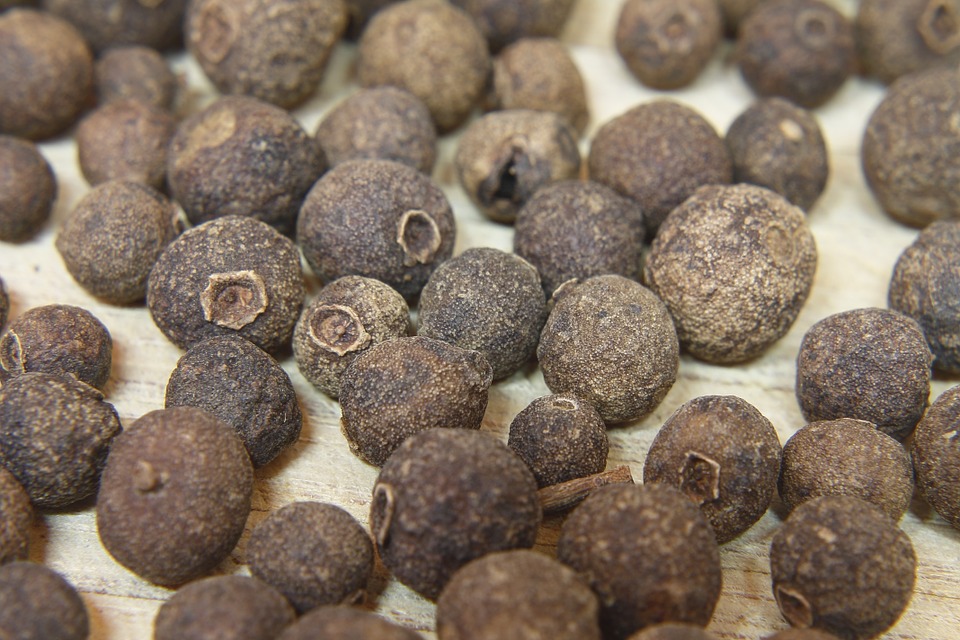Bay St-Thomas EO
Naturelle
Spicy > Warm Spices > Eugenolic > Balsamic

Crédits photo: ScenTree SAS
Latin name :
Pimenta racemosa
Botanical profile :
The St Thomas bay tree belongs to the Myrtaceae family and to the genus Pimenta.
Geographic origin :
Originally from the West Indies (mainly Dominican Republic, Martinique, Guadeloupe, Caribbean). It is also possible to find it in India
Chemotypes :
There are many varieties of Pimenta Racemosa, including:
Pimenta racemosa var. grisea
Pimenta racemosa var. hispaniolensis
Pimenta racemosa var. ozua
Pimenta racemosa var. racemosa
Pimenta racemosa var. terebinthine
Pimenta racemosa var. grisea
Pimenta racemosa var. hispaniolensis
Pimenta racemosa var. ozua
Pimenta racemosa var. racemosa
Pimenta racemosa var. terebinthine
Extraction process :
The Bay St-thomas tree can reach up to 20 meters high. Its cultivation requires a moderate climate and a certain altitude (about 77 °F at 750 meters).
Every year and throughout the year (drought periods are preferred), it is possible to collect the berries (fruits of the tree) in 1 to 3 harvests. The berries, harvested by hand, are sun-dried for several hours before being crushed and extracted by steam distillation. When drying, the initially green berries become brown and lose much of their water.
At the end of the extraction process, the essential oil is collected in an essencier by decantation.
It is also possible to extract the leaves which are used to aromatize local teas or rum.
Every year and throughout the year (drought periods are preferred), it is possible to collect the berries (fruits of the tree) in 1 to 3 harvests. The berries, harvested by hand, are sun-dried for several hours before being crushed and extracted by steam distillation. When drying, the initially green berries become brown and lose much of their water.
At the end of the extraction process, the essential oil is collected in an essencier by decantation.
It is also possible to extract the leaves which are used to aromatize local teas or rum.
Major Components :
Eugenol (70-90%)
IsoEugenol (≈6%)
Beta-Caryophyllene (4-8%)
IsoEugenol (≈6%)
Beta-Caryophyllene (4-8%)
- Uses in perfumery :
- Used in luxury perfumery in fresh, amber and spicy notes.
- Other comments :
- In 2017, a hurricane devastated the island of Saint-Thomas, the only island producing this spice. Then, the oil is no longer produced these days, and cultures have been replaced by corn cultivation.
The bay takes its name from the region of St. Thomas in Jamaica.
The leaves of the tree can be used to make tea or to aromatize dishes.
There is another extract sold as ''Bay '' that has no connection with the Bay of St. Thomas. In reality, it is the bay laurel, cultivated in Turkey in particular.
The adulteration of the essential oil is possible using natural Eugenol to reduce the cost of production. Nevertheless, the composition of the oil must comply with ISO standards and the shape of the bay is controlled by criterias given by specialized agencies. - Volatility :
- Heart
- Appearance :
- Brown liquid
- Stability :
- Solubility issues in perfumes
Aromatic compounds can be chromophoric and cause a coloration of the oil, especially in alkaline bases
The terpenes identified in this raw material can polymerize when they are oxidized - Price Range :
- €€€
- Aromatherapy :
Informations provided below are taken from reference works in aromatherapy. They are given for information purposes only and can not constitute medical information, nor engage the responsibility of ScenTree.
Bay St-Thomas essential oil has anti-infective, anti-inflammatory, spasmolytic and vasodilating properties. It is recommended in case of hair loss, dandruff, dermatological disorders (acne, herpes ...), digestive and ENT infections and inflammations, various neuralgia.

Crédits photo: ScenTree SAS
- EINECS number :
- 85085-61-6
- FEMA number :
- 2122
- Allergens :
- Eugenol
- IFRA :
- This ingredient is restricted by IFRA
- Annexe I :
- Some regulated synthetic ingredients are found in nature and in certain proportions in natural ingredients. This presence in nature has to be taken into account when calculating limits of use recommended by the IFRA. In case you do not know these concentrations, you can use the ones estimated by the IFRA. Here they are :
- Annexe I :
- Some regulated synthetic ingredients are found in nature and in certain proportions in natural ingredients. This presence in nature has to be taken into account when calculating limits of use recommended by the IFRA. In case you do not know these concentrations, you can use the ones estimated by the IFRA. Here they are :
| List of regulated compounds contained in this ingredient | ||
|---|---|---|
| Regulated ingredient name | CAS N° | Estimated Concentration |
| 1-Octen-3-yl acetate | 2442-10-6 | 0,3 |
| Estragole | 140-67-0 | 0,1 |
| Methyl eugenol | 93-15-2 | 2 |
| Eugenol | 97-53-0 | 51 |
| List of regulated compounds contained in this ingredient | ||
|---|---|---|
| Regulated ingredient name | CAS N° | Estimated Concentration |
| 1-Octen-3-yl acetate | 2442-10-6 | 0,3 |
| Estragole | 140-67-0 | 0,1 |
| Methyl eugenol | 93-15-2 | 2 |
| Eugenol | 97-53-0 | 51 |
To learn more about IFRA's standards : https://ifrafragrance.org/safe-use/library
ScenTree is solely responsible for the information provided here.

